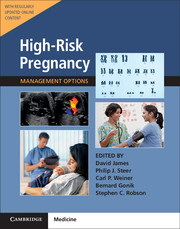Book contents
- High-Risk Pregnancy: Management Options
- High-Risk Pregnancy: Management Options
- Copyright page
- Contents
- Contributors
- Section 1 Prepregnancy Problems
- Section 2 Early Prenatal Problems
- Section 3 Late Prenatal – Fetal Problems
- Section 4 Problems Associated with Infection
- Chapter 24 Hepatitis Virus Infections in Pregnancy (Content last reviewed: 23rd July 2019)
- Chapter 25 Human Immunodeficiency Virus in Pregnancy (Content last reviewed: 23rd July 2019)
- Chapter 26 Rubella, Measles, Mumps, Varicella, and Parvovirus in Pregnancy (Content last reviewed: 11th November 2020)
- Chapter 27 Cytomegalovirus, Herpes Simplex Virus, Adenovirus, Coxsackievirus, and Human Papillomavirus in Pregnancy (Content last reviewed: 11th November 2020)
- Chapter 28 Parasitic Infections in Pregnancy (Content last reviewed: 15th June 2018)
- Chapter 29 Other Infectious Conditions in Pregnancy (Content last reviewed: 11th November 2020)
- Section 5 Late Pregnancy – Maternal Problems
- Section 6 Late Prenatal – Obstetric Problems
- Section 7 Postnatal Problems
- Section 8 Normal Values
- Index
- References
Chapter 29 - Other Infectious Conditions in Pregnancy (Content last reviewed: 11th November 2020)
Published online by Cambridge University Press: 15 November 2017
- High-Risk Pregnancy: Management Options
- High-Risk Pregnancy: Management Options
- Copyright page
- Contents
- Contributors
- Section 1 Prepregnancy Problems
- Section 2 Early Prenatal Problems
- Section 3 Late Prenatal – Fetal Problems
- Section 4 Problems Associated with Infection
- Chapter 24 Hepatitis Virus Infections in Pregnancy (Content last reviewed: 23rd July 2019)
- Chapter 25 Human Immunodeficiency Virus in Pregnancy (Content last reviewed: 23rd July 2019)
- Chapter 26 Rubella, Measles, Mumps, Varicella, and Parvovirus in Pregnancy (Content last reviewed: 11th November 2020)
- Chapter 27 Cytomegalovirus, Herpes Simplex Virus, Adenovirus, Coxsackievirus, and Human Papillomavirus in Pregnancy (Content last reviewed: 11th November 2020)
- Chapter 28 Parasitic Infections in Pregnancy (Content last reviewed: 15th June 2018)
- Chapter 29 Other Infectious Conditions in Pregnancy (Content last reviewed: 11th November 2020)
- Section 5 Late Pregnancy – Maternal Problems
- Section 6 Late Prenatal – Obstetric Problems
- Section 7 Postnatal Problems
- Section 8 Normal Values
- Index
- References
Summary
Infections are an important contributor to maternal and perinatal morbidity and mortality rates. The relative immunosuppression that occurs during pregnancy may alter the natural course of many infectious diseases. Higher attack rates for a variety of bacterial and viral infections are seen in pregnancy. Furthermore, many of these infections may be associated with adverse outcomes, including preterm labor and delivery, low birth weight, and stillbirth. This chapter addresses a large group of infectious diseases and conditions not discussed in other chapters, including streptococcal infections, listeriosis, common sexually transmitted infections (STIs), and vaginitis.
- Type
- Chapter
- Information
- High-Risk PregnancyManagement Options, pp. 728 - 778Publisher: Cambridge University PressFirst published in: 2017



